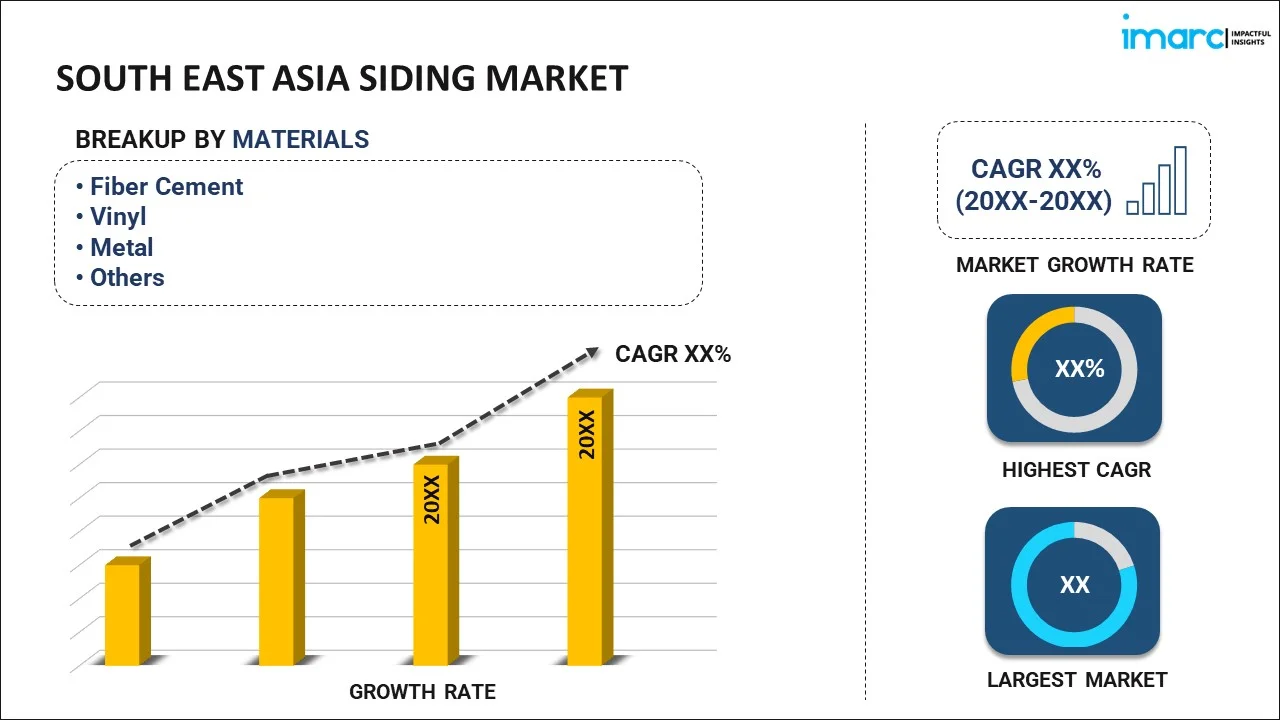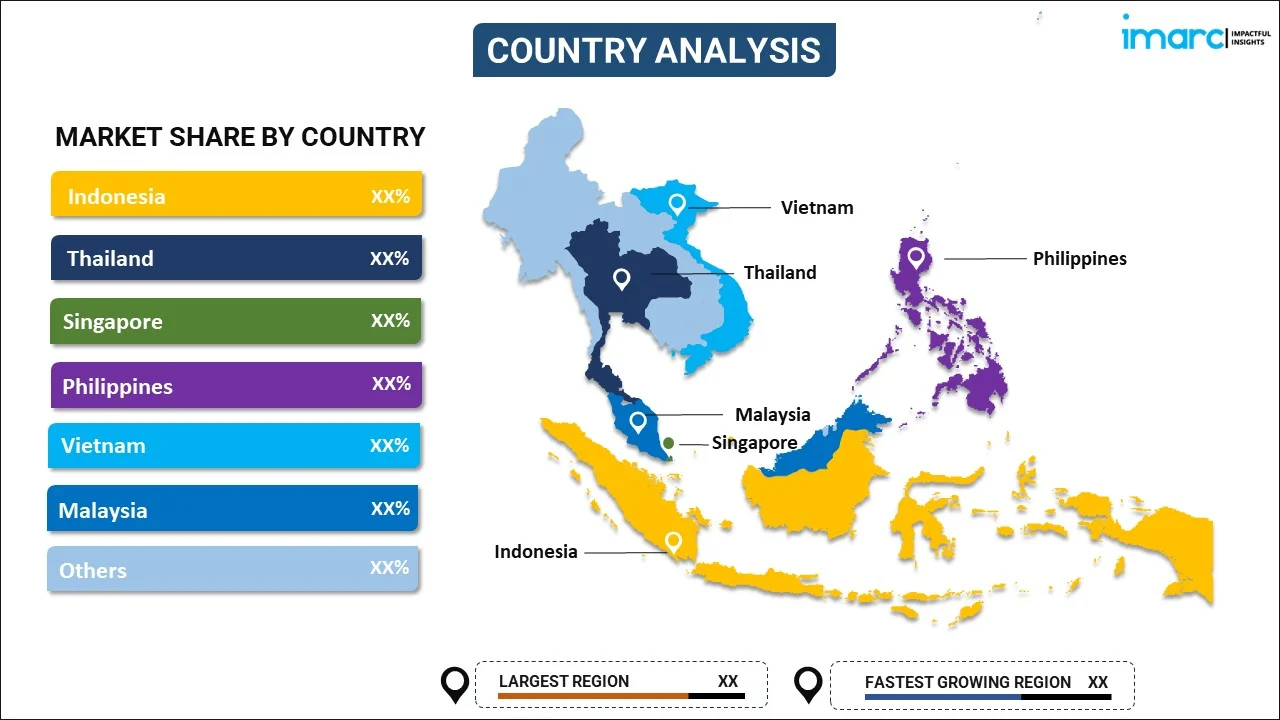
South East Asia Siding Market Report by Material (Fiber Cement, Vinyl, Metal, Stucco, Concrete and Stone, Brick, Wood, and Others), End Use (Residential, Non-Residential), Application (New Construction, Repair and Maintenance), and Country 2024-2032
Market Overview:
South East Asia siding market size is projected to exhibit a growth rate (CAGR) of 4.20% during 2024-2032. The increasing construction activities in South East Asia, growing urbanization in the region, rising emphasis on sustainability, recent innovation in siding materials and manufacturing process, and the heightened preference for eco-friendly siding materials represent some of the key factors driving the market.
|
Report Attribute
|
Key Statistics
|
|---|---|
|
Base Year
|
2023 |
|
Forecast Years
|
2024-2032
|
|
Historical Years
|
2018-2023
|
| Market Growth Rate (2024-2032) | 4.20% |
Siding refers to a material used to cover, protect, and aesthetically enhance the exterior walls of buildings. It is available in various types, such as vinyl, fiber cement, wood, aluminum, and brick, each with distinct characteristics. The manufacturing process of siding involves several steps, such as mixing, forming, and finishing steps, ensuring durability and aesthetic appeal. Siding finds applications in residential, commercial, and industrial buildings. It offers numerous benefits, such as improved building durability, enhanced energy efficiency, low maintenance requirements, and increased property value. Additionally, siding is known for its versatility in design, resistance to weather elements, improved sound insulation, fire resistance, and potential for recyclability.
South East Asia Siding Market Trends:
The increasing construction activities in South East Asia are facilitating the demand for siding in residential, commercial, and infrastructure projects for protection and aesthetic purposes. Furthermore, the growing urbanization in the region, leading to more high-rise and modern buildings, where siding is essential for façade aesthetics and protection, is catalyzing the market growth. Besides this, the tropical climate of South East Asia, which necessitates the use of durable and weather-resistant siding materials, is contributing to the market growth. Furthermore, the growing emphasis on sustainability, prompting the adoption of energy-efficient siding materials that provide better insulation, is propelling the market growth. In addition, the increasing desire for modern and aesthetically pleasing building exteriors among homeowners is driving the market growth. Apart from this, recent innovations in siding materials and manufacturing processes that are making products more durable, easier to install, and environmentally friendly are positively influencing the market growth. Moreover, the imposition of various government programs promoting infrastructure development is acting as another growth-inducing factor. Along with this, the increasing disposable income in the region, enabling more spending on home improvement and construction projects, is strengthening the market growth. Additionally, the heightened preference for eco-friendly siding materials, owing to escalating environmental concerns, is fueling the market growth. Furthermore, the rising demand for customizable siding options catering to diverse consumer preferences is bolstering the market growth. Besides this, the widespread installation of siding in new properties due to the expanding real estate sector is stimulating the market growth. Apart from this, the expanding tourism and hospitality sector, which utilize siding for aesthetic purposes, is supporting the market growth. In addition to this, the rapid expansion of retail spaces and commercial buildings is facilitating product demand, owing to its durability and attractiveness. Moreover, the implementation of stricter building codes and regulations regarding health and safety standards is positively impacting the market growth.
South East Asia Siding Market Segmentation:
IMARC Group provides an analysis of the key trends in each segment of the market, along with forecasts at the regional and country levels for 2024-2032. Our report has categorized the market based on material, end use, and application.
Material Insights:

- Fiber Cement
- Vinyl
- Metal
- Stucco
- Concrete and Stone
- Brick
- Wood
- Others
The report has provided a detailed breakup and analysis of the market based on the material. This includes fiber cement, vinyl, metal, stucco, concrete and stone, brick, wood, and others.
End Use Insights:
- Residential
- Non-Residential
- Healthcare
- Education
- Hospitality
- Retail
- Offices
- Others
A detailed breakup and analysis of the market based on the end use have also been provided in the report. This includes residential and non-residential (healthcare, education, hospitality, retail, offices, and others).
Application Insights:
- New Construction
- Repair and Maintenance
The report has provided a detailed breakup and analysis of the market based on the application. This includes new construction and repair and maintenance.
Country Insights:

- Indonesia
- Thailand
- Singapore
- Philippines
- Vietnam
- Malaysia
- Others
The report has also provided a comprehensive analysis of all the major regional markets, which include Indonesia, Thailand, Singapore, Philippines, Vietnam, Malaysia, and Others.
Competitive Landscape:
The market research report has also provided a comprehensive analysis of the competitive landscape. Competitive analysis such as market structure, key player positioning, top winning strategies, competitive dashboard, and company evaluation quadrant has been covered in the report. Also, detailed profiles of all major companies have been provided.
South East Asia Siding Market Report Coverage:
| Report Features | Details |
|---|---|
| Base Year of the Analysis | 2023 |
| Historical Period | 2018-2023 |
| Forecast Period | 2024-2032 |
| Units | US$ Million |
| Scope of the Report | Exploration of Historical and Forecast Trends, Industry Catalysts and Challenges, Segment-Wise Historical and Predictive Market Assessment:
|
| Materials Covered | Fiber Cement, Vinyl, Metal, Stucco, Concrete and Stone, Brick, Wood, Others |
| End Uses Covered |
|
| Applications Covered | New Construction, Repair and Maintenance |
| Countries Covered | Indonesia, Thailand, Singapore, Philippines, Vietnam, Malaysia, Others |
| Customization Scope | 10% Free Customization |
| Report Price and Purchase Option | Single User License: US$ 3699 Five User License: US$ 4699 Corporate License: US$ 5699 |
| Post-Sale Analyst Support | 10-12 Weeks |
| Delivery Format | PDF and Excel through Email (We can also provide the editable version of the report in PPT/Word format on special request) |
Key Questions Answered in This Report:
- How has the South East Asia siding market performed so far and how will it perform in the coming years?
- What has been the impact of COVID-19 on the South East Asia siding market?
- What is the breakup of the South East Asia siding market on the basis of material?
- What is the breakup of the South East Asia siding market on the basis of end use?
- What is the breakup of the South East Asia siding market on the basis of application?
- What are the various stages in the value chain of the South East Asia siding market?
- What are the key driving factors and challenges in the South East Asia siding?
- What is the structure of the South East Asia siding market and who are the key players?
- What is the degree of competition in the South East Asia siding market?
Key Benefits for Stakeholders:
- IMARC’s industry report offers a comprehensive quantitative analysis of various market segments, historical and current market trends, market forecasts, and dynamics of the South East Asia siding market from 2018-2032.
- The research report provides the latest information on the market drivers, challenges, and opportunities in the South East Asia siding market.
- Porter's five forces analysis assist stakeholders in assessing the impact of new entrants, competitive rivalry, supplier power, buyer power, and the threat of substitution. It helps stakeholders to analyze the level of competition within the South East Asia siding industry and its attractiveness.
- Competitive landscape allows stakeholders to understand their competitive environment and provides an insight into the current positions of key players in the market.
Need more help?
- Speak to our experienced analysts for insights on the current market scenarios.
- Include additional segments and countries to customize the report as per your requirement.
- Gain an unparalleled competitive advantage in your domain by understanding how to utilize the report and positively impacting your operations and revenue.
- For further assistance, please connect with our analysts.
 Inquire Before Buying
Inquire Before Buying
 Speak to an Analyst
Speak to an Analyst
 Request Brochure
Request Brochure
 Request Customization
Request Customization




.webp)




.webp)












